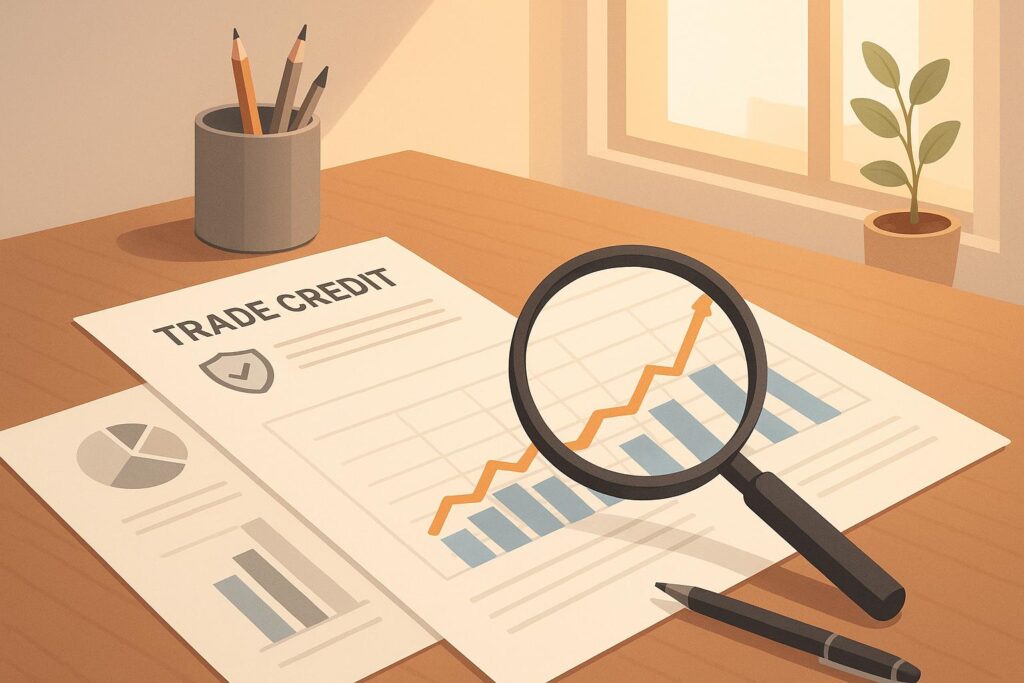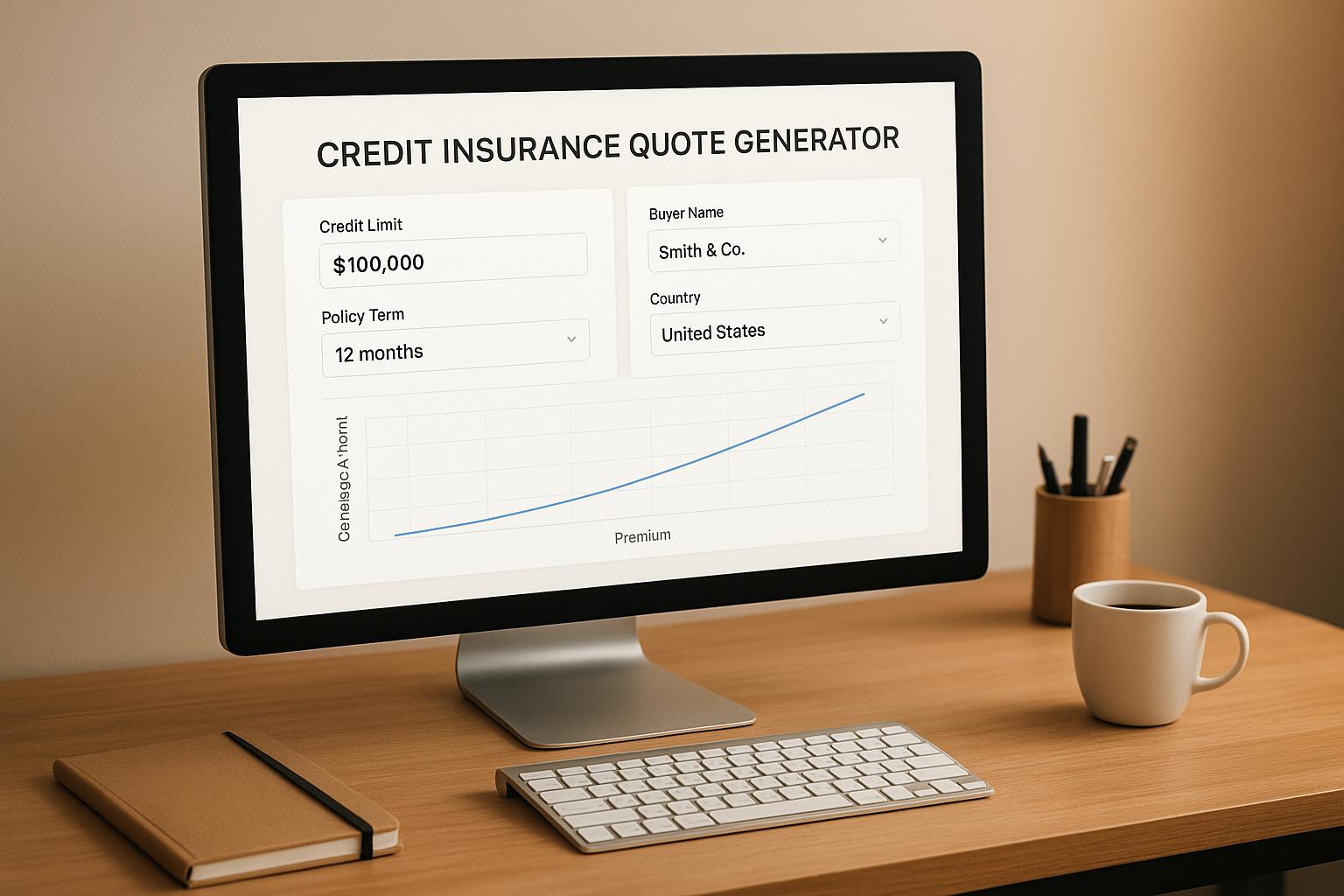Trade credit insurance premiums depend on several factors that shape your business’s risk profile. These include your industry type, customer creditworthiness, company financials, geographic risks, and claims history. Understanding these elements helps you manage costs effectively while ensuring adequate coverage.
Key factors that influence premiums:
- Industry Risk: Stable industries typically have lower premiums.
- Customer Creditworthiness: Strong credit histories reduce risk and costs.
- Company Financials: Revenue, bad debt history, and credit policies play a role.
- Geographic Risks: International transactions often cost more due to political and economic challenges.
- Claims History: Fewer claims and minimal bad debts can lead to lower premiums.
How much does Trade Credit Insurance (TCI) cost?
Main Factors That Affect Premiums
When insurers calculate trade credit insurance premiums, they consider several key factors that shape your overall risk profile. Knowing these elements can help you better understand potential costs and make smarter decisions about your coverage. Here’s a closer look at what goes into determining your premium.
Industry Risk Levels
The type of industry your business operates in plays a big role in setting premium rates. Insurers analyze the stability of your sector, factoring in things like market volatility, seasonality, and external influences. Generally, businesses in more stable industries tend to see lower premiums. For instance, companies in volatile sectors often rely on industry expertise to reduce risks. As Allianz Trade explains:
If you sell to clients in a mix of industries and countries, your trade credit insurance rates will reflect the risk determined to be associated with all of them.
Customer Creditworthiness
The creditworthiness of your customers is another major factor. Insurers look at the financial health and credit history of your client base – strong credit histories generally lead to lower premiums. They also monitor creditworthiness on an ongoing basis, assigning credit limits and flagging potential issues early on. To keep premiums under control, it’s a good idea to strengthen your internal credit risk management. This might include extending credit only to customers with proven payment records and regularly reviewing their financial stability.
Company Financials and Insured Turnover
Your company’s revenue, history of bad debts, and credit policies are all scrutinized when premiums are calculated. Typically, premiums are expressed as a percentage of your business’s turnover.
You can generally expect to pay about ¼ of a cent on every dollar of sales.
Most policies fall within the range of 0.1% to 0.4% of sales, with many priced at under 0.5% of turnover. A smaller turnover usually means a lower absolute premium. Insurers also often include a minimum premium in contracts to account for uncertainties in future revenue.
Geographic and Political Risks
Where your customers are located can also influence your premiums. Domestic sales usually carry less risk compared to international transactions, which can involve challenges like currency fluctuations, differing legal systems, and varying economic conditions. Political instability or regional disruptions can further increase the likelihood of non-payment, leading to higher premiums.
Claims History and Bad Debt Experience
Your history with bad debts and past insurance claims is a critical factor. Insurers use standard actuarial methods to review your bad debt records alongside broader economic and industry trends. Businesses with minimal bad debt and few claims are often rewarded with lower premiums, while those with a history of significant losses or frequent claims may face higher costs. This approach ensures that premiums align with your business’s specific risk level.
How Insurers Assess Risk and Set Premiums
Understanding how insurers evaluate risk can help businesses secure better insurance rates. This process involves a detailed analysis of your company’s financial health, credit practices, and overall risk exposure.
Reviewing Internal Credit Practices
Insurance underwriters take a close look at your company’s internal credit practices to identify any gaps or potential risks. They analyze key aspects of your operations, such as financial stability, market position, the quality of your debtors, and how risks are spread across your customer base. One critical factor they examine is your historical claims ratio – the percentage of claims compared to turnover. A high claims ratio might signal weak credit controls, which could lead to higher premiums.
Underwriters also prefer a diversified sales ledger, as relying heavily on just a few customers can increase risk. To assess the financial health of your debtors, they review balance sheets, income statements, and cash flow statements. This thorough evaluation helps insurers determine the likelihood of future claims and adjust premiums accordingly.
How Risk Assessment Services Work
In addition to internal reviews, insurers use specialized risk assessment services to measure exposure and design effective coverage. These services play a key role in evaluating risk and tailoring policies to meet specific business needs. For instance, Accounts Receivable Insurance provides risk assessments as part of its trade credit insurance solutions, helping businesses understand their unique risk profiles. These evaluations often include analyzing customer bases and credit practices to anticipate potential challenges.
Risk assessment providers also consider external factors like domestic and international risks. They analyze issues such as political stability, currency fluctuations, and regional economic trends that could impact your customers’ ability to pay. For example, recent data shows a 23.5% increase in business bankruptcies in the United States in 2025 compared to 2024, highlighting the importance of anticipating such risks.
The demand for trade credit insurance has grown significantly in recent years. In 2023, the U.S. trade credit insurance market was valued at $2.02 billion and is expected to grow at an annual rate of 10.6% from 2024 to 2030. These policies can even help offset their own costs by enabling businesses to increase sales and profits without taking on additional risk. Plus, the premiums are tax-deductible, adding another layer of financial benefit.
sbb-itb-2d170b0
How to Adjust Policies to Lower Premiums
Lowering insurance premiums often involves fine-tuning your coverage to align with your financial goals and risk tolerance. By making thoughtful adjustments, you can strike a balance between cost savings and adequate protection. These changes build on earlier risk evaluations to create a more budget-friendly insurance plan.
Changing Coverage Scope
The type of policy you select plays a significant role in determining your premium costs. For example:
- Whole turnover policies cover all eligible buyers in your customer base, offering broad protection. While comprehensive, they usually come with higher premiums.
- Single buyer policies focus on one high-risk or essential customer. These are often more affordable and work well if your risk is concentrated in a specific client.
- Partial turnover policies protect key accounts within a diversified customer base, allowing you to lower costs without sacrificing essential coverage.
- Key account policies concentrate on your largest clients, prioritizing your insurance budget for accounts where losses could have the most significant impact.
Selecting the right coverage scope ensures your policy aligns with your risk management strategy and financial priorities.
Adding Policy Features
Customizing your policy with additional features can address specific needs but may influence overall costs. For example:
- Adding political risk or export credit coverage can help manage international challenges, though it may increase premiums.
- Top-up policies provide extra protection beyond standard coverage, which can be useful for businesses seeking added security.
- For companies with variable or project-based sales, transactional coverage offers flexibility by insuring deals on a case-by-case basis.
These features allow you to tailor your policy to meet unique business requirements, though it’s essential to weigh their benefits against the potential cost.
Setting Deductibles and Coverage Percentages
Adjusting deductibles and coverage percentages is another way to manage premium costs. Opting for a higher deductible typically lowers premiums by reducing the insurer’s financial exposure. Similarly, reducing the insured percentage of each transaction can yield savings, but it’s important to balance these changes with your risk tolerance.
For example, during periods of strong cash flow, you might choose higher deductibles to save on premiums. Conversely, in uncertain times, increasing your coverage percentage can offer greater security. Accounts Receivable Insurance provides the flexibility to customize policies, ensuring they align with your financial strategy and risk profile.
How to Control Premium Costs
Lowering your insurance premiums isn’t just about understanding the factors that affect them – it’s about taking action. By combining strong internal practices with expert advice, you can reduce risks and demonstrate financial responsibility to insurers, which often translates to lower costs.
Strengthening Internal Credit Controls
Your internal credit management plays a big role in how insurers assess your business. Companies with well-organized credit controls are often seen as less risky, which can lead to better premium rates.
Start with thorough credit assessments for new customers. This means running credit checks, setting clear credit limits, and establishing straightforward payment terms. Keep an eye on payment patterns to catch potential issues early.
Automate reminders for overdue accounts and set up escalation processes to address late payments quickly. These steps not only improve cash flow but also show insurers that you’re serious about managing risk.
Accurate record-keeping is another key piece of the puzzle. Document customer communications, payment histories, and collection activities. This not only helps with day-to-day operations but also serves as proof of your proactive approach to risk management when dealing with insurers.
To simplify these processes, consider using credit management tools that offer automation and detailed reporting. These tools can save time and provide valuable insights.
Working with Insurance Specialists
Even the best internal controls can benefit from expert guidance. Insurance specialists bring a wealth of knowledge and resources to the table, helping you find the right balance between protection and cost.
For instance, Accounts Receivable Insurance uses in-depth risk assessments and taps into a global network of carriers to secure competitive rates. Their expertise ensures you’re getting strong coverage without overpaying.
Specialists can also help you fine-tune your policy. Whether it’s adjusting coverage percentages, modifying deductibles, or restructuring your policy’s scope, their insights can make a big difference – especially during policy renewals or when negotiating better terms.
Efficient claims management is another area where specialists shine. By fostering strong relationships with carriers, they can help keep premiums in check over the long run.
When choosing an insurance specialist, look for one who offers a thorough market analysis and a variety of coverage options. This ensures you’re not only getting competitive pricing but also the protection your business truly needs.
FAQs
What steps can businesses take to improve their credit practices and lower trade credit insurance premiums?
Businesses can save on trade credit insurance premiums by improving their internal credit processes. One effective approach is to align credit insurance with your overall credit policy, showcasing strong risk management practices. Regularly evaluating your customers’ creditworthiness and spreading coverage across a diverse portfolio can also help minimize exposure to high-risk accounts.
Another way to cut costs is by handling insurance claims as a backup plan rather than a first option. Proactively manage payment terms and keep a close eye on customer payment habits. These measures not only strengthen your financial position but can also lead to more competitive premium rates, offering savings while ensuring your business remains safeguarded against potential financial setbacks.
How can businesses manage geographic and political risks in international trade to reduce insurance costs?
To navigate geographic and political risks in international trade while possibly reducing insurance expenses, businesses can take several practical steps:
- Secure political risk insurance: This specialized coverage safeguards against losses stemming from political turmoil, government actions, or civil unrest, offering a financial safety net in unpredictable situations.
- Expand into diverse markets: Spreading operations across various regions lessens the dependency on a single country, reducing vulnerability to localized disruptions.
- Perform detailed risk evaluations: Regularly analyze the political and economic conditions of target markets to spot potential challenges early on.
- Establish reliable local partnerships: Partnering with knowledgeable and trustworthy local entities can provide critical insights and help navigate regulatory complexities with greater ease.
Taking these proactive measures not only helps businesses manage international risks effectively but can also position them as lower-risk entities, potentially leading to better insurance terms.
What are the pros and cons of whole turnover vs. single buyer trade credit insurance policies?
Whole turnover trade credit insurance covers all your receivables, offering extensive protection against risks like non-payment or bankruptcy. This type of policy can help stabilize cash flow, open doors to financing options, and support expansion into new markets. On the flip side, it often comes with higher premiums and might include coverage that doesn’t align with your specific needs.
On the other hand, single buyer policies are designed to cover specific customers, offering focused risk management and potentially lower costs. These policies can be a more budget-friendly choice, but their coverage is limited to individual buyers and may require thorough credit checks for each customer.
The best choice depends on your business’s approach to risk, the range of your customer base, and your overall financial objectives.



